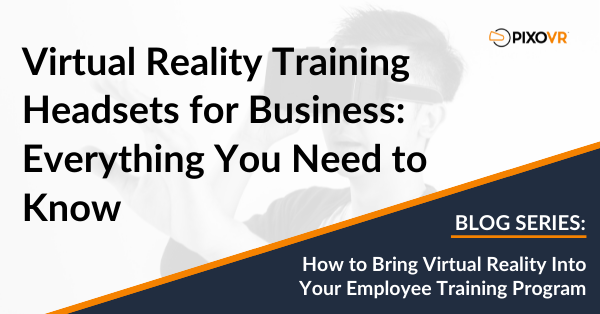The following is an excerpt from our whitepaper: ‘How to Bring Virtual Reality Into Your Employee Training Program’:
A major component in starting out with VR training is selecting the right equipment to make it happen and be as easy to manage as possible. Most VR training content is made to work on any VR headset. That said, you should review the content you are interested in and check hardware requirements.
The most basic VR headsets work with smartphones. These headsets or goggles are designed to hold the cell phone and deliver an immersive experience to the user. VR headsets are available for both Apple iOS and Android systems so trainees can access training easily at home, at the office, or anywhere else they’re working.
More advanced headsets have screen protectors and multiple viewfinders built-in to provide spatial orientation and position recognition. These systems deliver richer images faster, without the need for connecting wires. At just a slightly higher price point, the comfort and ease of use of wireless headsets can help boost learner engagement.
With the growing selection of VR headsets in the market, it can be difficult to determine which headsets are the right choice for your business. Below are a few features you should consider when evaluating headsets.
What to Look for in Virtual Reality Training Headsets for Business
- Distribution – Consider if you plan to distribute VR headsets to partners. For instance, some systems do not allow this and it could increase costs.
- Social media – Some headsets require users to login via a social networking account to register and activate headsets. This is typically a negative for business users.
- Smartphone – Some headsets require a particular type of smartphone to be used to set up the headset. Look for headsets that don’t require this to keep it simple.
- Wireless – Sideloading the content onto the headset may be fine for a classroom setting, but difficult to manage if training is done remotely. Consider wireless headsets if you plan to send the headsets to various locations.
- SD card – You may want to have multiple VR training modules loaded on a single headset which may require additional storage. Some headsets do not allow SD card storage, while others allow provisioning of headsets with additional SD card storage.
- Annual fees – Most headsets do not have an annual fee, but a few do! Be wary of fine print as one system charges $180 per device each year.
In addition to headsets, you will need VR training orchestration software to set up users, deliver content to the headsets wirelessly, manage progress, and track results. This software can also integrate with Learning Management Systems (LMS), which is helpful as you scale your use of VR training. The software can even track things like which questions were answered incorrectly so that training can be improved.
Lastly, you’ll need content. The VR training orchestration software has ready-to-use content and can accept custom content. You’ll want to work with your software vendor to determine which approach is right for your needs and to license the content.
Download the whitepaper: ‘How to Bring Virtual Reality Into Your Employee Training Program’


Leave a Reply
You must be logged in to post a comment.